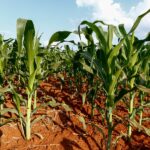Barley scald, also known as Rhynchosporium leaf scald, is a common fungal disease that affects barley plants. It is caused by the fungus Rhynchosporium secalis and can lead to significant yield losses if not properly managed. Here are the symptoms of barley scald that you should look out for:
- Leaf lesions: The primary symptom of barley scald is the appearance of small, oval-shaped lesions on the leaves. These lesions are initially greenish and water-soaked but turn tan to brown as they mature. They usually have a yellow halo around them.
- Lesion enlargement: The lesions can gradually enlarge and coalesce, forming larger irregular-shaped patches on the leaves. As the disease progresses, the lesions may cover larger portions of the leaf surface.
- Leaf discoloration: Infected leaves may exhibit a general yellowing or browning of the tissue surrounding the lesions. This discoloration can spread throughout the leaf, leading to premature senescence and death of affected leaves.
- Leaf tip necrosis: In some cases, the leaf tips may become necrotic (turn brown or black) due to the infection. This symptom is more common in susceptible barley cultivars.
- Spike and stem infection: As the disease progresses, the fungus may also infect the spikes and stems of barley plants. Infected spikes can show discoloration, shriveling, and reduced grain fill, while infected stems may exhibit dark lesions.
It’s important to note that the severity of symptoms can vary depending on environmental conditions and the susceptibility of the barley variety. Regular scouting and early detection of symptoms are crucial for implementing appropriate disease management strategies, such as fungicide applications or resistant cultivar selection. If you suspect barley scald in your crops, it is recommended to consult with local agricultural extension services or plant pathologists for accurate diagnosis and tailored management recommendations.
Join 'Farmers Mag' WhatsApp Channel
Get the latest Farming news and tips delivered straight to your WhatsApp
CLICK HERE TO JOIN






